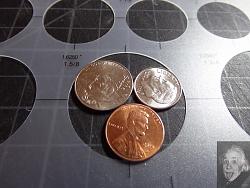I wrote about this subject before...
Soddy circles and plug gages
but I thought of a clever picture to demonstrate the idea so I wrote what follows. There's some overlap with the previous so if you feel the deja vu, just skip to the end.
Shops that need to make precision measurements of small holes usually use pin gauges. These tools eliminate the need for the user to develop a refined "feel" as is the case with split ball and telescoping gauges.
But what do you do if the hole has a diameter a bit bigger that your biggest pin gauge?
Here again mathematics comes to the aid of the machinist. If you have three circles of differing diameters with each tangent to the other two, it's possible to draw a circle around them that is tangent to all three. Mathematicians refer to this outer circle as the outer Soddy circle (yes, there's an inner Soddy circle). This means that, if we can snugly fit three pin gauges into the hole, we can calculate the diameter of the hole using the formula for the Soddy diameter, which is:
S = d1*d2*d3/{d2*d3+d1*(d2+d3)-2.*sqrt[d1*d2*d3*(d1+d2+d3)]}
where d1, d2, d3 are the diameters of the three pin gauges.
A visual may aid understanding... I measured the diameter of three coins...
penny: d1 = 0.748
nickle: d2 = 0.833
dime: d3 = 0.703
and calculated the resulting Soddy diameter
S = 1.647...
then laid these three coins tangent to each other on a 1.625 circle template...
Look carefully and you will see that the penny just slightly overhangs the edge of the hole. I'll bet the three coins would fit exactly into the circle if it were, say, oh, 1.647 in diameter.
On my page is the PLUG.ZIP archive. In it is a program to calculate both the inner and outer Soddy diameters given the three diameters. Also, there is a program to tell you which pin gauges to combine to measure a hole of given diameter. Given a rough measurement of the hole (say with calipers), this tells you which pins to try first to get an exact measurement.


 LinkBack URL
LinkBack URL About LinkBacks
About LinkBacks



 Reply With Quote
Reply With Quote

Bookmarks